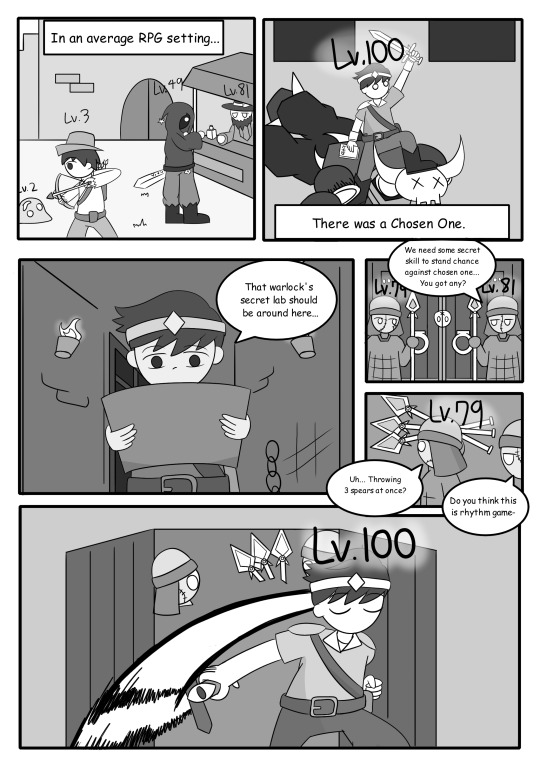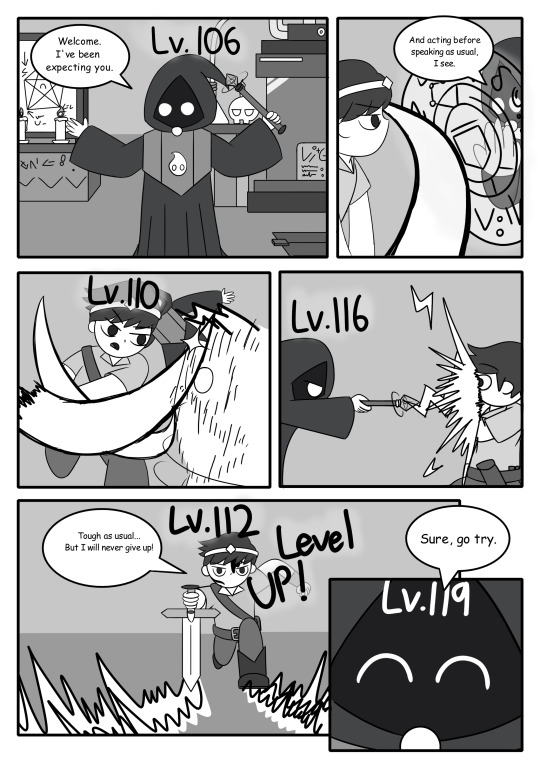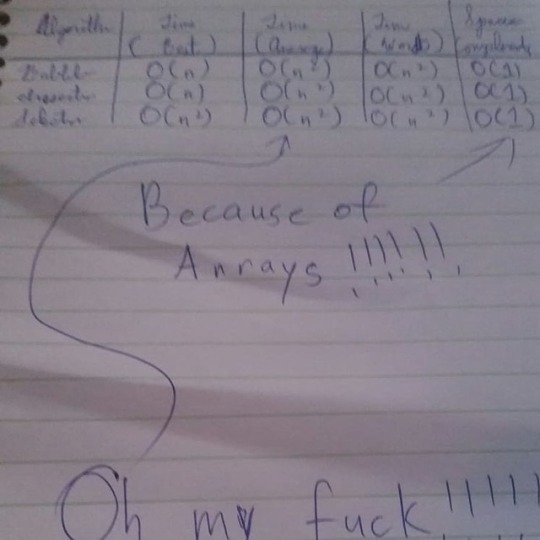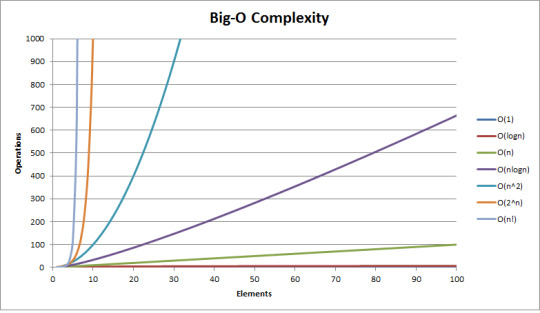#timecomplexity
Text
Unravel the mysteries of algorithms with our Time Complexity tutorial! Understand the efficiency of your code and optimize algorithms for faster execution. Learn the language of time complexity and make informed decisions in your programming journey. Enhance your coding skills with us!
1 note
·
View note
Text






Average Powerinflation Comic 1/3
Been busy making this
0 notes
Video
youtube
684. Redundant Connection
684. Redundant Connection
In this tutorial, I walk you through step-by-step on how to approach Redundant Connection🧠💡
Don't miss out on learning this essential algorithmic problem. Watch the video now and level up your programming skills! 💪💻
#Programming #Algorithm #LeetCode #Tutorial #ProblemSolving #JAVA #RedundantConnection #UnionFind
Approach
There are two conditions here
1) Create Union Find Class which consist of Parent and Rank as arrays
2)Initialize Parent array and Rank array with the Constructor
3)Create a function Find (here we create function called "Find" to find the parent of the node)
4)Create a function Union(here we create function called "Union" to union the two nodes and then increase the weight accordingly. If Union is not possible then there is a "Cycle" between two nodes)
5)Now use this class in main function of Redundant Connection to find the node which has redundant connection
#Summary: Union-Find Data Structure is used to find the connection between two nodes. Thus helps to determine whether two nodes are in the same connected component or not in the graph. It also helps in merging two nodes in the graph
#TimeComplexity : O(n)
0 notes
Photo

drama/The Peripheral
尼ドラマでは数少ないアタリなシリーズで
ある意味GHOST IN THE SHELLの
21世紀解釈的な答えというか、「電脳」
「義体化」「近代戦争後のディストピア」
に「TIMECOMPLEX」を
差し込んできて、ちゃんと進行していただけに、
一旦のオチをつけずにSeason1の
ぶつ切り的エンディングは残念でしかない。
完全に制作の手際の悪さ。
0 notes
Text
Time Complexity part_2 | What is it?
In the last post, we’ve talked about why is it important to understand time complexity of any program.
But wait! What exactly is time complexity? We’ve not talked about that yet.
Time complexity is basically the rate of growth of time taken by a program when the number of input increases. Please Note that time complexity is NOT the time taken by a machine to execute the task, it really depends on which machine is being used, single or multiple processors, available memory etc.
When we talk about time complexity, we basically talk about it’s dependency on the number of inputs.
Let’s understand it with an intuitive example:
Suppose you’re playing a game with a kid. You’ve put a surprise gift for him in a box but there are 8 similar looking boxes and the kid has to find the gift.
He has tried a box and found it empty, he tried the next and alas! That’s empty too.
How many boxes will he need to open, if he randomly picks a box to find the gift? What do you think?
If he’s lucky, he can find it in the first attempt but in the worst case, he might need to open all 8 boxes to find the gift.
So, time taken by him to get a gift would be proportional to the number of boxes, isn’t it? [More boxes, more time in worst case to find the box with a gift]
Next day, again you played the same game. But this time the boy behaved smartly.
Instead of choosing from the 8 boxes, he divided them into two equal parts and asked you for a hint, if the gift is in one of the boxes on the left or on the right. And based on the answer, he will search. So, he has to find the gift form only four boxes now. He again did the same trick and divided the boxes into two parts and asked you, if the gift is in the left side boxes or right-side boxes. So now, he needs to choose from two only. Again, he repeated the process again & finally found the box with the gift.
So, by doing this kind of search (we can call it binary search where we divide the search space by two in every iteration), the boy found the gift in maximum 3 iteration.
Let me introduce the jargon here.
For n inputs (here n=8), linear search (first approach of the kid) takes time complexity order of n [O(n)] as in the worst case, it takes ‘n’ iteration to search for the desired result.
While for n inputs (here n=8), binary search (second approach of the kid), takes time complexity order of log2n [O(log n)] as in the worst case, it takes ‘log2n’ [Note that: log28 = 3] iteration to search for the desired result.
Don’t worry about the math here!
But what did we learn here is that time complexity talks about rate by which a program execution time increases based on input parameters [we are not considering system’s performance here]
But how do we actually compute time complexity? We will discuss that soon.
Time for a quick quiz:
What would be the time complexity for the following programs?
1. def say_hi():
print(“hi, how are you?”)
say_hi()
2. for i in range(1, n):
print(“hi, how are you?”)
Answer to previous quiz: 1_ it iterates ‘n’ times and second loop iterates √n (which is less than ‘n’) times
Stay Tuned!
0 notes
Photo

Complexity is necessary for a programmer to know which algorithm has the lowest run time while writing code for efficient performance. ⠀ Almost every tech interview asks you to identify the running time complexity of a program so you better get yourself farmiliar with it. In this post I'm going to elaborate the Big O concept with examples. ⠀ 💻 🖥 ⌨🖱📱 ⠀ #complexity #timecomplexity #webdevelopment #softwaredeveloper #coders #development #softwaredeveloper #coder #gamedevelopment #pythoncode #codelife #softwaredevelopment #worldcode #softwaretesting #code #codex #programming_language #pythoncode #javaprogramming #programmingstudents #codelife #developerlife #webdevelopers #webdeveloper #software #programmingquotes #mycleancode https://www.instagram.com/p/B_2KNtQg7WE/?igshid=1bv7n2p5jqi2c
#complexity#timecomplexity#webdevelopment#softwaredeveloper#coders#development#coder#gamedevelopment#pythoncode#codelife#softwaredevelopment#worldcode#softwaretesting#code#codex#programming_language#javaprogramming#programmingstudents#developerlife#webdevelopers#webdeveloper#software#programmingquotes#mycleancode
0 notes
Photo

Know the Types of Sorting Algorithms in Java.
Zoom the image and know the time complexity of each sorting algorithm.
#clickmyproject#finalyearproject#finalyearstudents#onlineprojects#sortingalgorithm#java#javaalgorithms#timecomplexity
0 notes
Photo

Same program same output 4 different method and 4 different complexities. . . . This code is pretty much specific to jupyter notebook. This code clearly tells the importance of time complexity in the code. How different code of same problem works. . . . If you see the output it clearly tells you the time taken by different function. Thats the core reason why big companies always hiring process contain intense time complexity programs. . . . . Follow @aihindishow For more posts. . . #pythonprogrammer #pythonprogrammers #pythonprogramming #pythoncode #python3 #pythoncoding #pythoncoder #pythoncoders #programming #programmer #programmermemes #timecomplexity #bigonotation #jupyternotebook #jupyter #methods #array #datastructure #datastructures (at Lucknow, Uttar Pradesh) https://www.instagram.com/p/B9FHW03A6YZ/?igshid=19pr2bzch9gql
#pythonprogrammer#pythonprogrammers#pythonprogramming#pythoncode#python3#pythoncoding#pythoncoder#pythoncoders#programming#programmer#programmermemes#timecomplexity#bigonotation#jupyternotebook#jupyter#methods#array#datastructure#datastructures
0 notes
Photo

When your average case is also your worst case and you actually know what it means.......THANKS ARRAYS LOL!!!!!! #coding #datastructuresandalgorithms #learningtocode #computerscience #sortingalgorithms #timecomplexity #bubblesort #insertionsort #selectionsort #bigotime #computerscienceisfun #learningsomethingnew #learningtoimprove #selftaughtcoder #kazexmoug #learningtech #timecomplexity #spacecomplexity #runtimes #algorithms #softawareengineering #mathisfun #computerscienceforeveryone #codingmakesmehappy #mathisnotscary #teachyourselfcode #algorithmanalysis #gettingoutofmyhead #criticalthinking #entryleveltech https://www.instagram.com/p/Bz3ONFXpZYe/?igshid=ibaa3jipzdz
#coding#datastructuresandalgorithms#learningtocode#computerscience#sortingalgorithms#timecomplexity#bubblesort#insertionsort#selectionsort#bigotime#computerscienceisfun#learningsomethingnew#learningtoimprove#selftaughtcoder#kazexmoug#learningtech#spacecomplexity#runtimes#algorithms#softawareengineering#mathisfun#computerscienceforeveryone#codingmakesmehappy#mathisnotscary#teachyourselfcode#algorithmanalysis#gettingoutofmyhead#criticalthinking#entryleveltech
0 notes
Photo

7.11 Shell Sort algorithm | sorting algorithms | Full explanation with code | data structures http://ehelpdesk.tk/wp-content/uploads/2020/02/logo-header.png [ad_1] Step by step instructions showin... #abdulbari #academics #algorithm #bubblesort #cprogramming #calculus #chineselanguage #computerscienceengineering #computerscienceyoutubechannels #cse #datastructure #datastructures #datastructuresandalgorithms #englishconversation #englishgrammar #englishlanguage #frenchlanguage #gate #gatecomputerscience #germanlanguage #heapsort #ielts #informationtechnology #insertionsort #it #japaneselanguage #jayantikhatrilamba #jennylamba #jennyslectures #linearalgebra #math #mergesort #notes #probability #quicksort #selectionsort #shell #shellsort #signlanguage #sortingalgorithms #spanishlanguage #statistics #studymaterial #teaching #technical #thebible #timecomplexity #ugcnetcomputersciencepreparation
0 notes
Video
youtube
Optimization Problem using Greedy Algorithms || Knapsack Problem || Huff...
0 notes
Text
Time Complexity for Different Python functions(Big Oh notation)
Source: https://wiki.python.org/moin/TimeComplexity
0 notes
Video
youtube
Pascal Triangle
In this tutorial, I walk you through step-by-step on how to approach Pascal Triangle🧠💡
Don't miss out on learning this essential algorithmic problem. Watch the video now and level up your programming skills! 💪💻
#Programming #Algorithm #PascalTriangle #LeetCode #Tutorial #ProblemSolving #JAVA #DynamicProgramming #
Approach
There are two conditions here
1) Condition - At the beginning and ending of each row we have 1
2)Recurrence Relation - which helps to use Dynamic Programming over here
Steps:
1) Initialize List of List of Integer as Triangle
2) Triangle.add(new ArrayList)
3)Now add 1 to the first triangle(0)index
4)Now create new ArrayList for currRows and prevRows respectively
5)Add 1 to the beginning of currRows
6)For middle Numbers use recurrence relation
(prevRows.get(col-1)+prevRows.get(col))
7)Add 1 at the end of currRows
8)Return the triangle
#Summary: Dynamic Programming is the technique use to breakdown the problems into subproblems and store the solution of subproblems. At the end use the subproblem solution to find out final solution
#TimeComplexity : O(numRows2)
0 notes
Video
youtube
Master's Theorem || GATE Preparation
0 notes
Text
w2d4
More new material today with little time to digest yesterday’s! We discussed time complexity of algorithms today. Time complexity (represented mathematically as big O) describes the worst case runtime of an algorithm (independent of external factors such as computer hardware, compiler speed, etc.) in the form of mathematical functions such as ln(n), n^2, and so on.
The running times in functions in order from fastest to slowest are O(1), O(ln(n)), O(n), O(n*ln(n)), O(n^2), O(2^n), and O(n!). They can typically be determined by dissecting an algorithm or function and determining how many iterations, loops, or operations are occurring. They can also be determined by getting data points on runtime for varying numbers of elements.
Finally, we ended by doing some cool demos involving running benchmarks for bubble sort and merge sort on 1000, 3000, 4000, and 5000 elements, which showed that bubble sort was really slow (at least for large number of elements as it is pretty fast for smaller numbers of elements). While this lecture was interesting, I found many aspects of it confusing, like average case and amortized time. I guess that’s what I’ll be reading about this weekend! The rest of the day involved writing various functions, determining their time complexities, and then optimizing to decrease big O, including some cool implementations such as a MinMaxStackQueue to keep track of maxs/mins instantaneously in constant time while moving through different numbers instead of having to calculate the maxs/mins during every iteration of different numbers. This was very hard, as we created our own data structures to do this. Again, we barely had time to get to the last step (which still wasn’t working at the time of this writing so another thing to work on during the weekend :/).
Straight from bigocheatsheet.com is this graph below for a more visual depiction of the various big Os discussed in this post.

0 notes